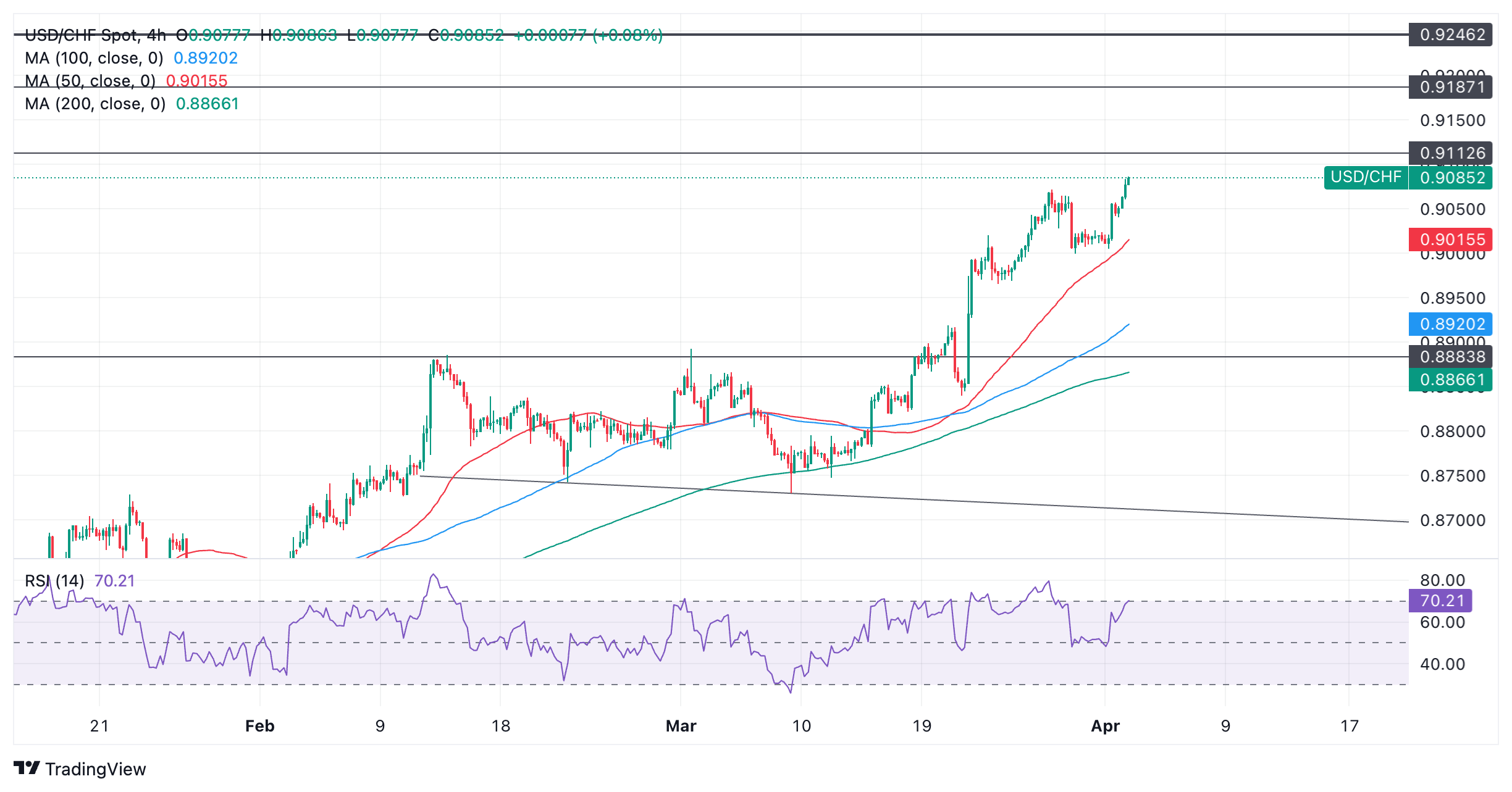- The Swiss Franc trades mixed – weakening to the US Dollar but up against the Euro and the Pound Sterling.
- Swiss data showed an unexpected decline in retail sales but an unforeseen recovery in manufacturing PMIs.
- The data suggests the SNB will not be diverted from its easing path.
The Swiss Franc (CHF) is trading mixed in its key pairs on Tuesday, mostly due to the fluctuations of its counterparts, to which it is playing the role of passive partner. Against the US Dollar (USD) the Swiss Franc is lower by almost half a percent in the 0.9080s (USD/CHF) whilst against the Euro and the Pound Sterling it is trading higher by a similar margin.
Swiss data out on Tuesday was mixed, with Real Retail Sales missing estimates by showing a 0.2% decline in February versus the 0.4% increase expected, according to the Federal Statistical Office.
Swiss SVME Manufacturing Purchasing Managers’ Index in March, on the other hand, beat expectations by coming out at 45.2 versus 44.9 forecast.
Swiss Franc mixed after Easter break
The Swiss Franc weakened in its most heavily traded pairs during March after the Swiss National Bank (SNB) took the unexpected step of cutting interest rates from 1.75% to 1.50% at its last policy meeting. This makes it the first major central bank to begin cutting interest rates. Lower interest rates are generally negative for a currency as they reduce capital inflows.
The SNB’s move came on the back of Swiss data showing a faster-than-anticipated slowdown in both inflation and economic growth during the last quarter of 2023 and beginning of 2024.
The continued mixed economic data – with Retail Sales in February falling compared to both the previous month and year, and Manufacturing PMI still below 50 and therefore in contraction – suggests there is unlikely to be a change in the thrust of the SNB’s policy towards favoring lower interest rates.
This should keep the pressure up on the Franc, especially against USD, given lower bets that the Federal Reserve (Fed) will cut interest rates early given continued robust economic data.
Technical Analysis: USD/CHF continues trending higher
USD/CHF – the number of Swiss Francs that can be bought with one US Dollar (USD) – extends its uptrend.

US Dollar versus Swiss Franc: 4-hour chart
The pair is threatening to print overbought, according to the Relative Strength Index (RSI), assuming a bullish close on the current four-hour bar. If so it will recommend that bulls do not add to their positions as the pair is at risk of pulling back.
Beyond that, the pair is overall seen continuing the intermediate-term uptrend. The next target lies at 0.9113, but it is soft – tougher resistance does not appear until the cluster of daily moving averages (not shown) at the 0.9187 level, followed by the key highs at 0.9246.
It would take a deeper slide below 0.8960 to bring into question the dominance of the uptrend and suggest the possibility of a reversal.
A break back inside the old range, confirmed by a move below 0.8890, would be required to mark a short-term trend reversal and the start of a deeper slide.
Swiss Franc FAQs
The Swiss Franc (CHF) is Switzerland’s official currency. It is among the top ten most traded currencies globally, reaching volumes that well exceed the size of the Swiss economy. Its value is determined by the broad market sentiment, the country’s economic health or action taken by the Swiss National Bank (SNB), among other factors. Between 2011 and 2015, the Swiss Franc was pegged to the Euro (EUR). The peg was abruptly removed, resulting in a more than 20% increase in the Franc’s value, causing a turmoil in markets. Even though the peg isn’t in force anymore, CHF fortunes tend to be highly correlated with the Euro ones due to the high dependency of the Swiss economy on the neighboring Eurozone.
The Swiss Franc (CHF) is considered a safe-haven asset, or a currency that investors tend to buy in times of market stress. This is due to the perceived status of Switzerland in the world: a stable economy, a strong export sector, big central bank reserves or a longstanding political stance towards neutrality in global conflicts make the country’s currency a good choice for investors fleeing from risks. Turbulent times are likely to strengthen CHF value against other currencies that are seen as more risky to invest in.
The Swiss National Bank (SNB) meets four times a year – once every quarter, less than other major central banks – to decide on monetary policy. The bank aims for an annual inflation rate of less than 2%. When inflation is above target or forecasted to be above target in the foreseeable future, the bank will attempt to tame price growth by raising its policy rate. Higher interest rates are generally positive for the Swiss Franc (CHF) as they lead to higher yields, making the country a more attractive place for investors. On the contrary, lower interest rates tend to weaken CHF.
Macroeconomic data releases in Switzerland are key to assessing the state of the economy and can impact the Swiss Franc’s (CHF) valuation. The Swiss economy is broadly stable, but any sudden change in economic growth, inflation, current account or the central bank’s currency reserves have the potential to trigger moves in CHF. Generally, high economic growth, low unemployment and high confidence are good for CHF. Conversely, if economic data points to weakening momentum, CHF is likely to depreciate.
As a small and open economy, Switzerland is heavily dependent on the health of the neighboring Eurozone economies. The broader European Union is Switzerland’s main economic partner and a key political ally, so macroeconomic and monetary policy stability in the Eurozone is essential for Switzerland and, thus, for the Swiss Franc (CHF). With such dependency, some models suggest that the correlation between the fortunes of the Euro (EUR) and the CHF is more than 90%, or close to perfect.

























